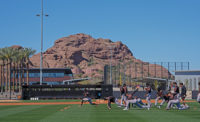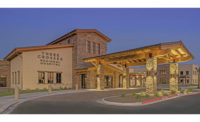$12B Las Vegas-to-California High-Speed Rail Launches
For Southern Californians, Las Vegas may appear close geographically, but it is painfully distant when actually making the trip. The drive across the desert typically takes more than four hours, even without counting traffic congestion during the trip’s onset.
The prospect of paring down the time and limiting the driving the trip requires took a step forward this week with the groundbreaking of Brightline West’s high-speed rail line on April 22. When complete, the full trip between stations in Rancho Cucamonga and Las Vegas will take about two hours, or roughly half the current driving time.
“This is a historic project and a proud moment where we break ground on America's first high-speed rail system and lay the foundation for a new industry.”
—Wes Edens, Founder, Brightline
“People have been dreaming of high-speed rail in America for decades, and now, with billions of dollars of support made possible by President Biden’s historic infrastructure law, it’s finally happening,” said U.S. Transportation Secretary Pete Buttigieg at the event.
The $12-billion effort to construct a 218-mile-long rail line between Las Vegas and Southern California began with a blast of confetti and the ring of hammers on rails at the site of the planned station in Las Vegas. The rail line will run down the middle of Interstate 15, using zero-emission electric trains capable of speeds of 200 miles per hour.
The route for the train has full environmental clearance and will run within the median of the interstate. Trains will stop in Las Vegas as well as in Victor Valley, Hesperia and Rancho Cucamonga, Calif.
“This is a historic project and a proud moment where we break ground on America’s first high-speed rail system and lay the foundation for a new industry,” Wes Edens, Brightline’s founder, said at the event.
Brightline, the only private provider of eco-friendly, intercity passenger rail service in America, says the privately led infrastructure project will be constructed and operated by union labor. Expected to complete in time for the 2028 Olympics, the rail line will also include 322 miles of overhead lines to power the trains and 3.4 million sq ft of retaining walls.
Although a contractor for the project has not yet been selected, the civil and rail infrastructure portion of the project is being led by HNTB in California and Jacobs in Nevada.
Last December, the Nevada Dept. of Transportation (NDOT) was awarded $3 billion in funding from the Federal-State Partnership for Intercity Passenger Rail Grant Program for the Brightline West project. The $3-billion grant is the largest in NDOT’s history. As the grant administrator, the agency will continue to play an important oversight role as Brightline West constructs the rail system. Additionally, NDOT will be responsible for the design, construction and oversight of any infrastructure that requires modification as a result of Brightline West’s work.
The rest of the project costs will be privately funded, although the federal government has taken steps to assist in making financing more attractive for investors. To date, the project has received a total allocation of $3.5 billion in private activity bonds from USDOT. The bonds give privately financed transportation projects access to tax-exempt bonds. That reduces the borrower’s interest rate for the bonds and, DOT says, increases the private sector’s presence in financing infrastructure projects.
The Las Vegas station will sit on 110 acres and include easy connections and access to the Las Vegas Strip; Allegiant Stadium, home of the Raiders football team; and the Las Vegas Convention Center. Brightline West’s California stations will include Victor Valley and Rancho Cucamonga, with direct connectivity via California Metrolink to key points in Los Angeles, such as Union Station.
A 200,000-sq-ft vehicle maintenance facility (VMF) is also part of the project and will be located in Sloan, Nev. It will be the base for daily maintenance and staging of trains.
The project’s environmental features are designed in line with Nevada and California’s climate strategies by promoting a no-emission mobility option that lowers greenhouse gasses by more than 400,000 tons of CO2 each year. By taking people out of cars and planes, the project will reduce vehicle miles traveled by more than 700 million each year and eliminate 16,000 short haul flights annually, says the company.
To further reduce the projects environmental impact, Brightline West has penned an agreement with the California Dept. of Fish and Wildlife (CDFW) to include wildlife crossings along the route. These will cross over the existing northbound and southbound highway lanes as well as the future high-speed rail system within the median.
By Greg Aragon
Construction Begins on Mesa, Ariz., Treatment Plant Expansion
Construction recently began on the expansion of Signal Butte Water Treatment Plant in Mesa, Ariz., a $56.6-million project on 84 acres.
McCarthy Building Cos. is general contractor for the project, with Black & Veatch as engineer-of-record on the multiphase plant expansion. The project includes the construction of an 8-million-gallon potable water reservoir and additional redundancies to ensure system reliability and provisions for future expansion. Phase I is expected to complete in October 2026. Preconstruction is underway on the second phase, set to be complete in summer 2027.
Phase II will double the plant’s capacity from 24 million to 48 million gallons of water per day and will add a mirrored, sand-ballasted flocculation, ozone generation and sodium hypochlorite generation disinfection process as well as solids handling. During construction, all elements of the water treatment facility will remain operational.
The plant was master-planned to accommodate future expansions, of which this is the first since its 2018 opening, driven by the growth and development in southeast Mesa. Raw water that feeds the treatment plant comes from the Central Arizona Project (Colorado River). The plant utilizes a state-of-the-art ozone oxidation purification process to treat the water and meet rigorous drinking water standards.
Logistics Center Underway In Goodyear, Ariz., Eyeing Late 2024 Completion
Phoenix-based Stevens-Leinweber Construction (SLC) has begun construction on Camelback 303 Logistics Center on behalf of Brookfield Properties. The LEED-certified, two-building industrial development will total 616,100 sq ft, offering Class A amenities and expansive trailer and outdoor storage capacity at Goodyear’s Loop 303 industrial corridor.
The project sits within PV303, a 1,600-acre master-planned industrial park by Merit Partners. With completion planned in the fourth quarter of 2024, the logistics center includes a 303,500-sq-ft Building A and 312,000-sq-ft Building B, each featuring 36-ft clear heights, LED lighting, 79 dock-high and four drive-in doors and 3,000 amps of power. Buildings A and B will also offer 185 ft to 370 ft of secured concrete truck courts; parking for up to 329 cars and up to 214 trailers; and electric vehicle charging stations.
Lots immediately adjacent to both buildings will provide space for a variety of industrial outdoor storage uses, including the ability to park up to another 376 trailers. Butler Design Group is project architect.
“This is a unique land use plan, where each building represents less than 15% coverage of its overall site,” says Erik Powell, vice president at SLC in an announcement. “It gives Camelback 303 Logistics Center a storage amenity that is extensive for a project of this size.”





Post a comment to this article
Report Abusive Comment